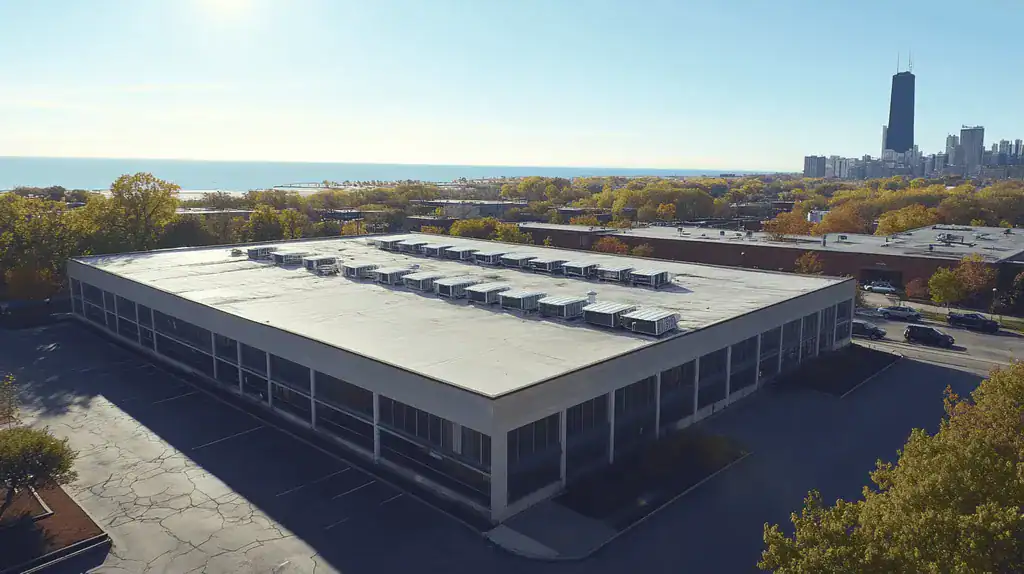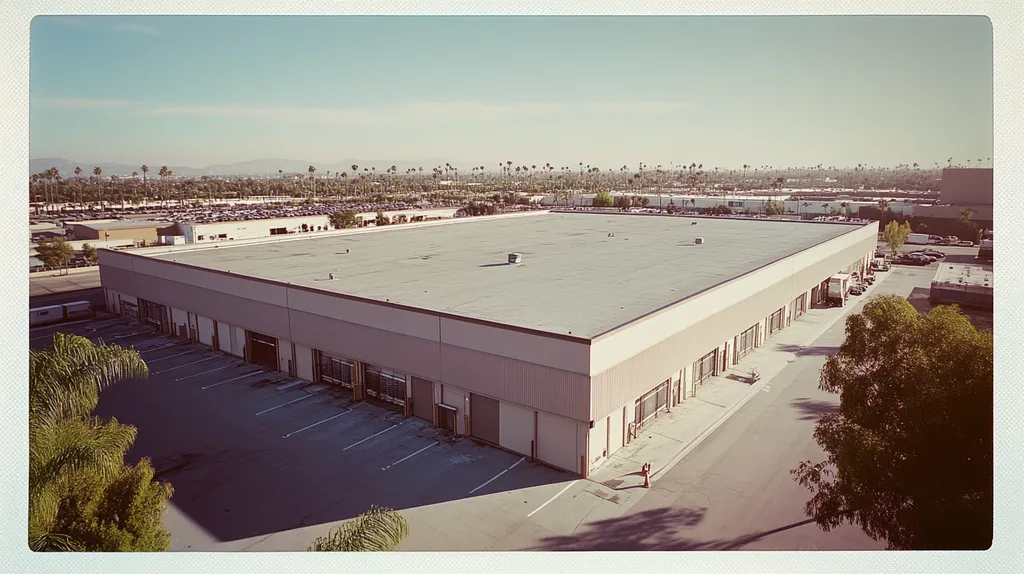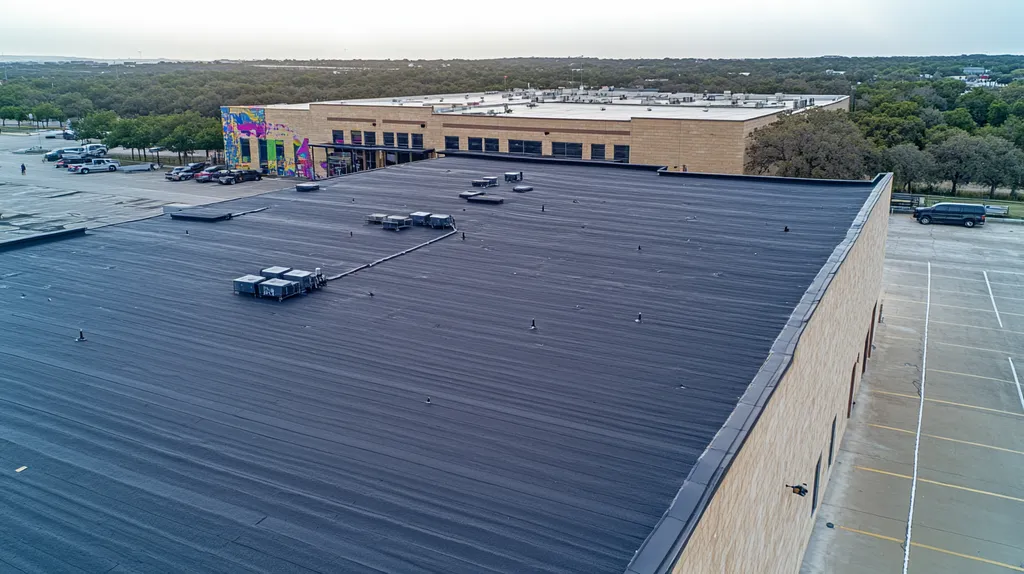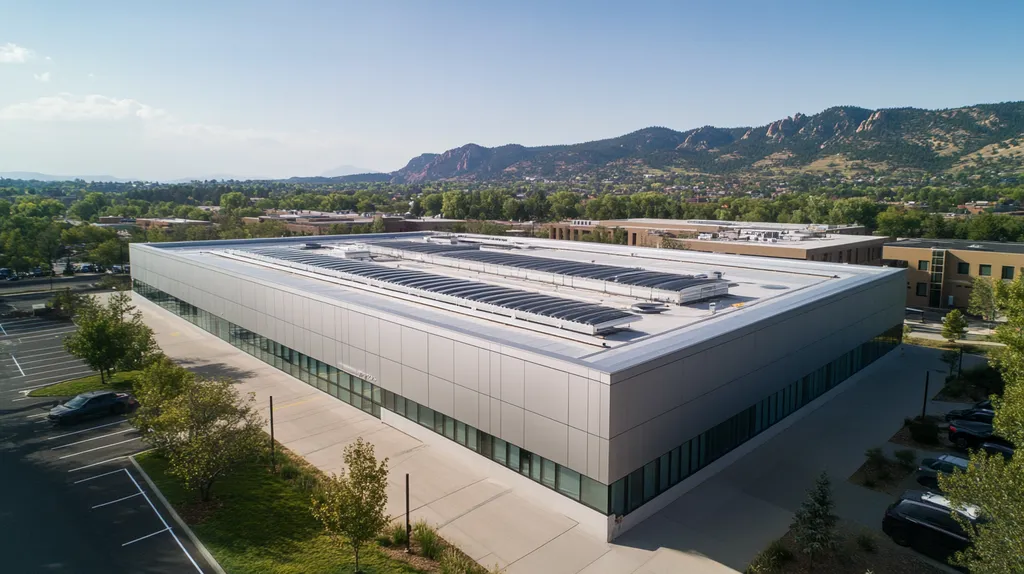Commercial roof coatings directly impact millions of dollars in equipment and operations, yet 40% of facility managers report coating-related damage to rooftop systems annually. From HVAC units to satellite equipment, the wrong coating choice can lead to costly failures.
The stakes are particularly high as coating decisions affect both immediate operations and long-term infrastructure integrity. Recent industry studies show coating failures account for 23% of commercial roof replacements.
This comprehensive guide examines critical factors in coating selection, application methods, and maintenance protocols that protect valuable rooftop investments while ensuring operational continuity.
SECTION 1: PERFORMANCE FACTORS
The effectiveness of coatings on commercial roofs directly influences the durability and functionality of the entire roofing system. Alarmingly, about 30% of facility managers indicate that poor coating decisions lead to expensive repairs and damage to essential equipment. Choosing the appropriate coating extends beyond visual appeal; it profoundly affects energy efficiency, weather resistance, and lifespan. Recognizing and evaluating these performance factors is crucial for making knowledgeable choices.
Coating Selection Criteria
Selecting the right roofing coating involves a careful assessment of various performance factors. First, it is vital to ensure compatibility with existing roofing materials to prevent any adverse reactions. For instance, while a property owner may consider a silicone coating for an EPDM roof, neglecting to conduct proper compatibility tests can lead to compromised integrity.
The local environment plays a pivotal role in coating selection. Coatings must withstand specific weather conditions such as heavy rain, snow, or intense heat. For example, reflective coatings excel in sunny areas, while elastomeric coatings are more suitable for regions prone to temperature swings.
Other essential considerations include coating thickness and application methods, which directly influence performance. Thicker coatings generally provide enhanced UV resistance and durability, while spray applications can offer a uniform layer on intricate roof geometries.
Cost-effectiveness is also a significant factor. While budget-friendly options may seem tempting, it is essential to weigh the long-term advantages against the initial expenses to ensure financial prudence.
Key Action Items
Adhesion and Durability Tests
Adhesion and durability tests are essential for understanding the long-term reliability of roof coatings. These assessments determine how effectively a coating bonds to the underlying substrate, which can significantly impact overall performance. A coating with poor adhesion may result in peeling or bubbling, causing further issues down the line.
Simple tests, such as the tape test, offer quick insights into adhesion quality. A strong bond signifies the coating can endure physical stress and environmental challenges, safeguarding the underlying roofing components.
Durability testing often involves simulating severe weather conditions through accelerated exposure to UV light and moisture cycles, which can help predict the coating’s performance over time. Coatings exhibiting minimal degradation in these tests are typically more dependable.
Utilizing thorough adhesion and durability evaluations allows facility managers to make educated choices that minimize long-term risks and expenses.
Key Action Items
Weather Resistance and UV Protection
Weather resistance and UV protection are critical characteristics of effective roof coatings. Coatings that lack resilience against rain, snow, and heat can lead to deteriorating roof surfaces, resulting in leaks and damage to internal equipment. It’s estimated that 20% of roof failures stem from moisture infiltration.
UV protection is especially vital, as ultraviolet rays can degrade many coating types over time. Coatings specifically formulated with UV inhibitors can greatly prolong their lifespan, thus safeguarding the roofing surface underneath and any important equipment that may be affected by leaks.
When evaluating coatings, it is crucial to examine their performance ratings against extreme weather conditions. Coatings designed with high resistance to harsh climates often include advanced polymers that enhance durability and longevity.
In conclusion, emphasizing weather resistance and UV protection not only improves the roof’s overall performance but also minimizes maintenance costs, ensuring the facility’s operational integrity is preserved.
Key Action Items
SECTION 2: FINANCIAL CONSIDERATIONS
Facility managers are continually challenged to optimize their budgets while delivering high-quality roofing solutions. The financial impact of roof coatings can be significant over time, making it vital to assess their economic implications. By understanding the cost-benefit analysis, planning for maintenance costs, and identifying potential savings, property owners can make educated choices about roofing coatings that align with their financial goals.
Cost-Benefit Analysis of Coatings
Conducting a cost-benefit analysis is essential when considering roof coatings. Though the initial installation costs might appear high, these expenses can be counterbalanced by the longevity and energy efficiency improvements coatings typically provide. Research shows that a well-maintained coating can extend the life of a roof by up to 50 percent.
Moreover, coatings enhance energy efficiency by reflecting sunlight, which reduces cooling expenses and can even allow property owners to take advantage of rebates. Therefore, what may seem like a steep upfront investment can lead to noteworthy savings on energy bills in the long run.
Facility managers can gain better financial insights by weighing these considerations, which ultimately helps justify the choice of roofing solutions. Importantly, recognizing how coatings interact with existing equipment is crucial, as poor compatibility can lead to unexpected costs. Choosing the right coating preserves the budget for future needs.
Key Action Items
Budgeting for Coating Maintenance
Budgeting for ongoing maintenance is crucial when selecting roof coatings. Regular inspections and maintenance are necessary to ensure the longevity of coated roofs. Setting aside funds for routine upkeep can save significant repair costs down the road.
Establishing a maintenance schedule right after the coating is applied is a best practice. This proactive measure allows for early detection of wear and tear, enabling timely repairs. Neglecting to include these expenses in the budget can lead to larger financial strains if problems escalate.
Additionally, facility managers should consider the costs of any special equipment or services required for maintenance. By planning comprehensively, they can address both immediate and long-term needs effectively. Training staff on fundamental maintenance practices can further reduce costs by minimizing dependence on outside contractors.
Key Action Items
Potential Cost Savings from Coatings
Investing in roof coatings can lead to considerable cost savings, making them a wise decision for facility managers. One of the primary savings comes from reduced energy consumption; quality roof coatings can lower indoor temperatures, thereby decreasing air conditioning needs and costs.
Additionally, by prolonging the life of the roof, property owners can avoid expensive replacement costs. Instead of needing a new roof every 20 years, a coated roof can last up to 40 years with proper maintenance.
Improved roof integrity can also lead to decreased insurance premiums, as insurers may provide discounts for buildings with preventive maintenance strategies supported by coatings. This approach contributes further to financial benefits, emphasizing the importance for managers to consider all aspects of roofing investments.
Key Action Items
SECTION 3: COMPLIANCE REQUIREMENTS
Facility managers must navigate a complex landscape of compliance requirements, where the stakes are high. Non-compliance can result in hefty fines, significant operational downtime, and potential legal challenges. Regulatory bodies like the Environmental Protection Agency (EPA) enforce stringent standards, making it essential for facility managers to stay informed. Understanding compliance not only ensures operational efficiency but also demonstrates a commitment to environmental responsibility.
Regulatory Compliance for Coatings
Commercial roofing coatings must adhere to a myriad of regulations at the federal, state, and local levels. The EPA specifies acceptable chemical formulations and sets limits on emissions, emphasizing the need for low volatile organic compounds (VOCs) to reduce air pollution.
Facility managers should remain vigilant about regulatory changes to avoid using non-compliant products. Regular audits of the materials used can identify issues before they escalate, protecting both the roofing system and the budget.
Regional laws can impose even stricter requirements, further complicating product selection. Collaborating with regulatory bodies can aid in choosing compliant coatings that fulfill all necessary obligations.
Key Action Items
Environmental Impact Considerations
Facility managers must consider the environmental implications of their coating choices. Selecting coatings that enhance energy efficiency can significantly reduce a building’s cooling costs while mitigating the heat island effect in urban areas.
It’s also crucial to assess how coating materials might affect local ecosystems. Some products could leach harmful substances into water sources or soil, posing environmental risks. A thorough understanding of these effects can guide managers toward safer, more responsible options.
Using eco-friendly coatings not only fulfills compliance but also bolsters a company’s green image. As customers increasingly prioritize sustainable practices, demonstrating environmental responsibility can enhance business reputation.
Key Action Items
Compliance with Industry Standards
Maintaining compliance with industry standards—such as those set by the American National Standards Institute (ANSI) and the National Roofing Contractors Association (NRCA)—is essential for facility managers. These organizations establish detailed guidelines on coating application, performance, and lifespan.
Familiarizing with these standards is crucial to ensure roofs perform optimally while meeting safety and durability criteria. Compliance can also play a significant role in warranty claims, bolstering the case for product reliability.
Choosing third-party certified coatings enhances assurance that products meet strict industry benchmarks, simplifying compliance verification. Establishing strong partnerships with manufacturers familiar with these standards can further aid in selecting compliant and high-performing coatings.
Key Action Items
SECTION 4: RISK MANAGEMENT
Coating failures in commercial roofing are not just inconveniences; they can incur severe financial and safety risks. Neglected coatings may crack or peel, leading to leaks and decreased building efficiency. Industry research reveals that over 30% of these issues can necessitate costly repairs, disrupting business operations. For facility managers and property owners, recognizing and managing these risks is essential. This section focuses on detecting potential coating failures, ensuring safe installation practices, and minimizing slippage and fall hazards during the process.
Identifying Potential Coating Failures
Spotting potential coating failures is essential for preserving roof integrity. Factors like extreme weather exposure and UV radiation can degrade coatings over time. Facility managers should conduct regular roof inspections for signs of peeling, bubbling, or discoloration, which are telltale indicators of underlying issues.
Adopting a routine inspection schedule is crucial in detecting problems early. Without regular assessments, coatings may fail without notice, leading to avoidable and expensive repairs. Proactive measures ensure that the coating continues to protect the roof effectively against environmental damage.
Compatibility of the chosen coating with existing roofing materials is another critical consideration. Employing incompatible products can result in premature failure, such as peeling or chipping. Evaluating the previous layer’s material is vital to select the appropriate coating type, preserving long-term performance and stability.
Including qualified roofing professionals in the evaluation process enhances the insights gathered. They can recognize nuanced signs of deterioration that may escape the notice of untrained personnel. By staying informed, facility managers can better prepare for maintenance and necessary replacements, keeping their roofing systems in prime condition.
Key Action Items
Safety Risks During Coating Installation
The coating installation process presents significant safety risks for workers on commercial roofs. Slopes, unpredictable weather, and working at heights can heighten danger levels. Statistics show that falls are a leading cause of injuries in the roofing industry, emphasizing the need for rigorous safety measures.
Effective training and safety protocols are vital during installation. Workers must properly use personal protective equipment (PPE), including harnesses and non-slip footwear. Insufficient safety measures can lead to accidents, posing harm to employees and triggering liability claims for property owners.
Ensuring a clutter-free workspace is equally important. Debris and obstacles on the roof increase the risk of slips and falls. Facility managers should establish clear communications with contractors to create an organized work environment before any coating application begins.
Lastly, having a robust emergency response plan is essential. Facility managers should collaborate with contractors to ensure everyone is aware of evacuation routes and first aid procedures. Safety should be a prioritized collaboration to minimize risks throughout coating installations.
Key Action Items
Mitigating Slippage and Fall Hazards
Mitigating slippage and fall hazards is critical for protecting workers during roof coating installation. Installing non-slip coatings or adhesives on walking surfaces can greatly enhance traction, significantly reducing the risk of accidents.
Temporary walkways made from durable materials can also provide safe paths for workers on the roof. Clearly marking these paths helps maintain awareness and minimizes potential missteps. Facility managers must ensure that these walkways are in place before work begins.
Monitoring weather conditions diligently is another effective strategy. Rain or dew can lead to slippery surfaces, prompting the need to reschedule work to avoid safety risks. Addressing these concerns can ensure a safer work environment during coating applications.
Lastly, encouraging workers to participate in safety briefings before any projects commence fosters a culture of safety awareness. By embedding safety into the process, the likelihood of incidents declines significantly, benefiting both employees and the overall operations of the facility.
Key Action Items
SECTION 5: OPERATIONAL PROCEDURES
Applying coatings to commercial roofs is a process that demands careful attention to operational procedures. Inadequate preparation can lead to a staggering 30% rate of premature roof failures, resulting in costly repairs or even complete system replacements. To prevent these issues, property owners and facility managers must follow structured steps before, during, and after the coating process. This section outlines crucial operational procedures that ensure a successful coating application.
Pre-Coating Preparation and Inspection
A meticulous approach to preparation is key for successful coating applications. Begin with a comprehensive inspection of the roof to identify any existing issues, such as leaks, areas of pooling water, or deteriorating materials. Addressing these problems upfront is crucial, as they can significantly impact the effectiveness of the coating.
Prepare the roof surface by ensuring it is clean and free of contaminants that could hinder adhesion. This may involve a thorough cleaning process, potentially using high-pressure washing to remove dirt, debris, and oil.
Next, conduct moisture tests to verify that the roof is dry prior to coating application, as many coatings require specific humidity levels for optimal performance. Additionally, plan for equipment and material accessibility to ensure that all necessary tools and safety gear are on-site, minimizing interruptions during the application.
Key Action Items
Coating Application Best Practices
The application of roof coatings must adhere in strict accordance with manufacturer guidelines regarding temperature, humidity, and methods. Adhering to these specifications is vital to ensure optimal adhesion and proper curing of the coating.
Select the right application technique—brush, roller, or sprayer—based on the roofing material and coating type. Each method has a distinct impact on coverage and finish, which can influence the long-term durability of the roof.
Maintain a consistent application rate to avoid creating thin spots or overlaps, as these can lead to performance issues. Regular inspections during the coating process are equally important, allowing for spot checks to ensure uniformity and adherence to specified standards.
Key Action Items
Post-Coating Maintenance and Repair
Proactive maintenance following the application of coatings is critical for their longevity and effectiveness. Schedule regular inspections to spot early signs of wear such as bubbling or peeling. Promptly addressing these issues can prevent further damage and prolong the life of the roof.
Implement a regular cleaning schedule to remove dirt and debris, as this helps maintain the coating’s reflectivity and contributes to energy efficiency. Additionally, ensure that all rooftop equipment, including flashing around vents, is properly maintained to prevent water intrusion.
Finally, maintain a detailed log of inspections and repairs, as this record will assist in future planning and improve communication with contractors regarding coating performance.
Key Action Items
SECTION 5: OPERATIONAL PROCEDURES
Applying coatings to commercial roofs demands strict adherence to operational procedures to prevent unnecessary failures. Research indicates that inadequate preparation can result in a 30% chance of premature roof failures, translating into costly repairs or complete replacements. Property owners and facility managers must implement thorough steps before, during, and after the coating process to maximize both performance and longevity. This section details essential operational procedures that contribute to successful coating applications.
Pre-Coating Preparation and Inspection
Thorough preparation is vital for a successful coating application. A detailed roof inspection should be the first step to identify existing issues such as leaks, pooling water, or deteriorating materials. Ignoring these points can severely impact the effectiveness of the coating.
Next, ensure the roof surface is clean and free from contaminants that could impede adhesion. Chemicals, dirt, or oil must be removed, often requiring high-pressure washing to ensure a suitable application surface.
Additionally, conduct moisture tests to confirm that the roof is adequately dried, as many coatings need specific humidity levels for optimal performance. Finally, ensure that all equipment and materials are readily accessible to streamline the application process and minimize work interruptions.
Key Action Items
Coating Application Best Practices
Proper application is crucial for ensuring the longevity and performance of roof coatings. Facilities must strictly follow manufacturer guidelines regarding temperature, humidity, and application techniques to ensure optimal adhesion and curing of the coating.
Choose the right application method—brush, roller, or sprayer—based on the specific roofing material and type of coating. Each technique affects coverage and finish, which can impact the roof’s overall durability.
Maintain consistency during application to avoid thin spots or overlaps, which can compromise performance. Regular inspections during the application process are essential, allowing for immediate corrections to maintain compliance with specification standards.
Key Action Items
Post-Coating Maintenance and Repair
After the coating is applied, proactive maintenance is critical to ensure its success. Schedule regular inspections to identify early signs of wear, such as bubbling or peeling. Timely action on these issues can prevent further damage and extend the roof life.
Implement a routine cleaning schedule to remove dirt and debris. Regular maintenance helps preserve the coating’s reflectivity, contributing to energy efficiency and overall roof durability.
Ensure the condition of all rooftop equipment is also checked, especially around flashing and other penetrations, as these areas can be vulnerable to water intrusion if not properly sealed. Keep a detailed maintenance log of inspections and repairs to assist with future planning and improve communication with contractors regarding coating performance.
Key Action Items
The Bottom Line
With 40% of facilities reporting coating-related equipment damage annually, the stakes for proper coating selection and maintenance have never been higher.
Commercial property owners must recognize that coating decisions directly impact millions in rooftop assets, from HVAC systems to satellite equipment.
The rising costs of equipment replacement – averaging $150,000 per incident – underscore the critical nature of implementing comprehensive coating strategies.
By following established protocols for coating selection, application, and maintenance, facility managers can significantly reduce the risk of equipment failure while extending roof life by up to 50%.
The future of commercial roofing demands a balanced approach that protects both immediate operations and long-term infrastructure investments through informed coating decisions.
FREQUENTLY ASKED QUESTIONS
Q. What performance factors affect commercial roof coatings?
A. The effectiveness of coatings relies on compatibility, local climate, thickness, and application methods. Consider these factors carefully to ensure optimal durability and functionality of your roofing system.
Q. How can commercial roof coatings impact finances?
A. Investing in quality coatings may yield long-term savings through enhanced energy efficiency and prolonged roof lifespan. Conducting a cost-benefit analysis helps assess both immediate and future financial impacts for your roofing projects.
Q. What compliance requirements should I consider for commercial roofs?
A. Ensure that your roof coatings comply with federal, state, and local regulations, including safety and environmental standards. Regular audits can help keep your material choices in line with compliance requirements and avoid penalties.
Q. How can I identify potential coating failures on my roof?
A. Conduct regular inspections for signs such as cracking, peeling, or discoloration. These indicators reveal underlying issues and help maintain the roof’s integrity for improved performance.
Q. What best practices should I follow during coating application?
A. Follow manufacturer guidelines for temperature and humidity. Consistent application rates, proper cleaning, and observing conditions during application enhance the lifespan and functionality of the coating.
Q. How important is post-coating maintenance for commercial roofs?
A. Proactive post-coating maintenance is vital for extending the roof’s life. Scheduled inspections, cleaning, and prompt repairs help identify issues early, preserving both performance and efficiency.
Q. Can roof coatings impact energy efficiency improvements?
A. Yes, high-quality coatings can significantly enhance your roof’s energy efficiency by reflecting heat. This reduces cooling costs and minimizes energy consumption, making them a smart investment.











